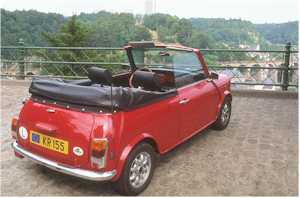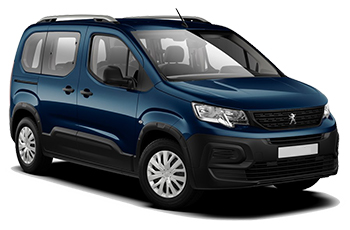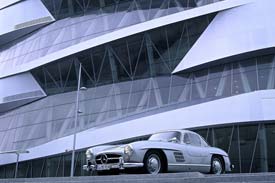|
Europe
> Car travel > Driving in
Europe
Driving in Europe

ABOVE: A vintage cabriolet on a corniche road in Luxembourg.
INSET BELOW: Minicars in Montmarte, Parisian parking.
By
Durant Imboden
 Car
travel in Europe can be a joy or a nightmare, depending on where and when you
drive. Car
travel in Europe can be a joy or a nightmare, depending on where and when you
drive.
During August, when countless millions of Europeans pack up their family
cars and drive to the beaches or mountains, traffic jams can rob even the most
scenic European touring routes of their charm.
And at any time of year, driving
in
a major city like London, Paris, or Rome can be nerve-wracking (or at
least unpleasant) to the foreign tourist.
When to come
Spring and fall are the best times for a motoring vacation in Northern and
Central Europe. In Southern Europe, winter can also be pleasant if you avoid the
Christmas break. If your vacation is tied to the school calendar, try visiting
in June, before the summer season reaches its peak.
Where to go
 Many tourists, especially those from North America, make the mistake of
planning car itineraries built around Europe's largest cities. They end up
having to cope with nerve-wracking traffic, scarce parking, and unfamiliar
regulations--all while trying to catch a glimpse of the sights through a mass of
cars, motorscooters, bikes, and tour buses. Many tourists, especially those from North America, make the mistake of
planning car itineraries built around Europe's largest cities. They end up
having to cope with nerve-wracking traffic, scarce parking, and unfamiliar
regulations--all while trying to catch a glimpse of the sights through a mass of
cars, motorscooters, bikes, and tour buses.
Other driving strategies are more practical:
- Take the train between major cities. Rent cars for local or regional
excursions, or for legs of your trip (e.g., Paris to the Riviera) where
you want to stop and enjoy sights along the way.
- Plan a motoring tour around smaller cities and towns. Enjoy your week in
London or Paris without a vehicle, then pick up your rental car and
start driving. Save other big cities for a future trip. (And don't be
tempted to stay in a suburban hotel and commute into the city center--you'll
miss out on the essence of the cities you're visiting.)
- Visit a country like Denmark, Norway, or Sweden where even the largest
cities are relatively car-friendly and you can leave town for driving excursions
with a minimum of hassle.
Tips on renting a car

ABOVE: The Peugeot Rifter is a popular crossover
vehicle.
Residents of countries outside the U.S. can save money with
short-term tourist leases from Peugeot, Citroën,
and Renault.
-
Comparison shop. Check prices at
European brokers that specialize in leisure rentals and short-term leasing
programs. Check each company's age restrictions
if you're under 25 or over 65, and see "Lease for longer trips" below.
-
Plan carefully. Rent a car for only as
long as you'll need it, to avoid early-return penalties. If you're on a
budget, avoid drop-off charges by planning a circular itinerary.
-
Book ahead. If you live outside
Europe, you're likely to get a better deal by making arrangements from
abroad.
-
Lease for longer trips. A short-term
car
lease from
Peugeot, Citroën, or Renault cn save money on rentals of 21 days or more. Such "buy back" or
"purchase-repurchase" leases are especially useful for students and senior
citizens, since age restrictions are minimal. (Tip: You'll save the most
money by picking up and dropping off your vehicle in France, where these car
manufacturers and leasing programs are based.)
-
Think small. Fuel is expensive in
Europe, streets are narrow in many cities, and small cars are easier to park
than large ones. Unless you need a large car or van, stick with a small to
midsize car.
-
Shift for yourself. Cars with
automatic transmissions can be hard to find and expensive to rent in many
countries. They also use more fuel. (Exception: If you're uncomfortable with
the idea of shifting gears with your left hand, a car with automatic
transmission may be worth the extra cost in Britain and Ireland.)
-
Important note: If you're picking up a
rental car outside the European Union, you may encounter
bureaucratic hassles if you later decide to drop the car off in an EU
country. To avoid potential problems, ask for a car that's regisftered in
the EU if you plan to drive there.
Tips on driving in Europe
-
Prepare at home. European regulations, driving
customs, and road signs can be confusing to foreigners, so use the
information resources below to learn
the basics ahead of time.
-
Be alert. If you're from North
America, forget about turning on the cruise control and floating along in
the left lane while listening to Santana and slurping coffee from your
MegaMug. You could have a panic attack when a BMW comes tearing up behind
you, left flasher blinking, at 250 km/h (156 mph) or faster. And if you've
never had to enter or exit a traffic circle (a.k.a. rotary or roundabout) in
heavy traffic, get ready for a new experience--especially if local laws give
priority to traffic coming from the right.
-
Carry an International Driving Permit.
This passport-like document (sometimes called an International
Driver's License) is a translation of your home license. It's required in
some countries and optional in others, but it's well worth having to avoid
problems if you're stopped by the police or want to rent a car in a foreign
country. See our
International Driving
Permit article.
Related articles
Car Rentals: When to Rent, When to Lease
europeforvisitors.com
Use the comparison chart in this article to help determine whether you should
consider a traditional car rental or a short-term lease.
Short-Term Car Leasing
europeforvisitors.com
Our article
describes what to expect when you lease a Peugeot, Citroën, or Renault for 21
days or more. It includes
Auto
Europe links for all three "buy back" programs.
Rental-Car Insurance
europeforvisitors.com
Do you need liability insurance in Europe? Should you pay extra for a Collision
Damage Waiver, or can you rely on your credit card's free coverage? This Europe
for Visitors article has the answers.
Car or Train?
europeforvisitors.com
Should you tour Europe on four wheels or ride the rails? Use this quiz and
related resources to make a wise decision.
International Driving Permit europeforvisitors.com
The IDP is an official document that certifies the validity of your home
driver's license in 150 countries. (But beware of so-called "International
Driver's License" scams.)
Europe by Van and Motorhome
europeforvisitors.com
Relive the '60s in a VW van or cruise the Continent in a land yacht.
General information
European
International Road Signs and Conventions
The interface may be more confusing than a Parisian roundabout, but be
patient--and scroll down for links to pages on traffic signs.
European Parking Guide
Icarehireinsurance has put together an infographic
that shows parking signs and markings. The page also discusses parking laws and
etiquette in several Western European countries.
Which Side of the Road Do They
Drive On?
Brian Lucas describes his informative and entertaining article
as "an attempt to list which side of the road people drive on around the world,
and to find some reasons why."
Country Information

ABOVE: A classic Mercedes 300SL gullwing
sports car outside the
Mercedes-Benz Museum
in Stuttgart, Germany.
France
Driving in France
Explore France covers the basics.
Car
Tourism in Germany
Read our articles about car museums and factory tours, a high-speed "race
taxi," a self-drive "Trabi Safari" tour in Dresden or Berlin, and more.
Autobahn Online
If you can't read the German text, try
The Autobahn, from
Brian's Guide to Getting Around Germany, and Hyde Flippo's
Autobahn
articles from
The German Way and More.
Tank & Rast
See what facilities are available at the 338 gas stations, 382 service areas,
and 51 hotels on Germany's Autobahn network.
Greece
Driving
in Greece: Renting a Car
DeTraci Regula's article is at Tripsavvy.com.
Italy
Autostrade per
l'Italia
Use the journey planner to design an itinerary or check traffic conditions at
the official Italian motorway site, where you'll also find a handful of
articles in English.
Portugal
Driving
in Portugal
Learn basic rules, regulations, and other facts from Portugal-info.net.
Spain
Driving and
Motoring in Andalucia
Most of this advice from Andalucia.com
is applicable to Spain as a whole.
Switzerland
Driving
in Switzerland switzerlandforvisitors.com
This article is from our
Switzerland
and Austria pages.
United Kingdom
VisitBritain: Guide to Driving in the UK
The country's national tourist office tells everything you need to know before
hitting the road in Britain.

ABOVE: You can drive a VW Touareg on the
off-road course at Volkswagen's Autostadt
in Wolfsburg, Germany.
Route planner
ViaMichelin
Use the "Driving Directions" form to plan your trip, or request an online map
from the ViaMichelin database.
Car rentals
Auto Europe
our partner
Rent a car in any of 4,000+ locations, with guaranteed low rates for
equivalent cars. Short-term tourist leases from Peugeot, Citroën, and Renault
are also available.
About the author:
 Durant Imboden
is a professional travel writer, book author, and editor who focuses on European
cities and transportation. Durant Imboden
is a professional travel writer, book author, and editor who focuses on European
cities and transportation.
After 4-1/2 years of covering European travel topics for About.com, Durant and
Cheryl Imboden co-founded Europe for Visitors in
2001. The
site has earned "Best of the Web" honors from Forbes and The
Washington Post.
For more information, see
About
Europe for Visitors,
press clippings, and
reader
testimonials.
|